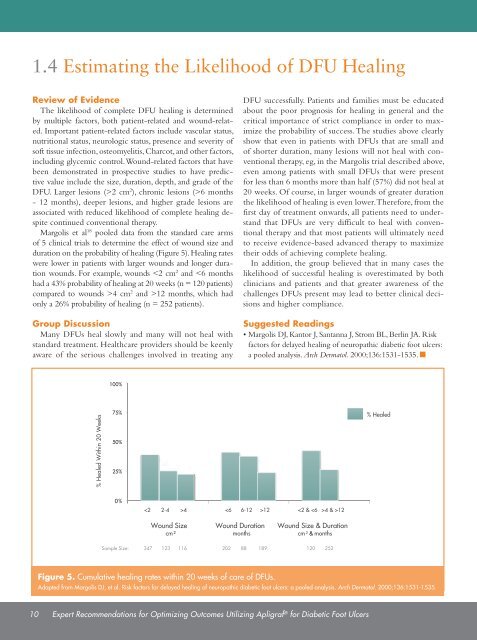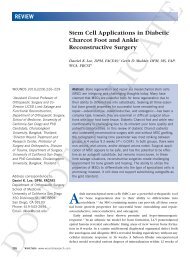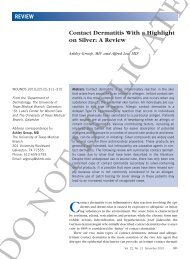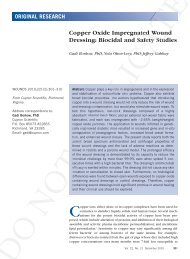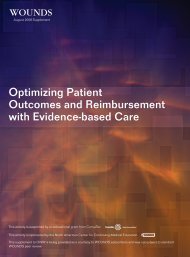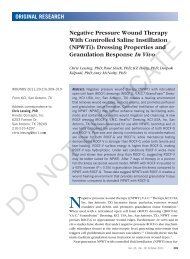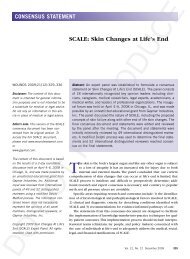Expert Recommendations for Optimizing Outcomes ... - Wounds
Expert Recommendations for Optimizing Outcomes ... - Wounds
Expert Recommendations for Optimizing Outcomes ... - Wounds
Create successful ePaper yourself
Turn your PDF publications into a flip-book with our unique Google optimized e-Paper software.
1.4 Estimating the Likelihood of DFU Healing<br />
Review of Evidence<br />
The likelihood of complete DFU healing is determined<br />
by multiple factors, both patient-related and wound-related.<br />
Important patient-related factors include vascular status,<br />
nutritional status, neurologic status, presence and severity of<br />
soft tissue infection, osteomyelitis, Charcot, and other factors,<br />
including glycemic control. Wound-related factors that have<br />
been demonstrated in prospective studies to have predictive<br />
value include the size, duration, depth, and grade of the<br />
DFU. Larger lesions (>2 cm 2 ), chronic lesions (>6 months<br />
- 12 months), deeper lesions, and higher grade lesions are<br />
associated with reduced likelihood of complete healing despite<br />
continued conventional therapy.<br />
Margolis et al 18 pooled data from the standard care arms<br />
of 5 clinical trials to determine the effect of wound size and<br />
duration on the probability of healing (Figure 5). Healing rates<br />
were lower in patients with larger wounds and longer duration<br />
wounds. For example, wounds 12 months, which had<br />
only a 26% probability of healing (n = 252 patients).<br />
Group Discussion<br />
Many DFUs heal slowly and many will not heal with<br />
standard treatment. Healthcare providers should be keenly<br />
aware of the serious challenges involved in treating any<br />
DFU successfully. Patients and families must be educated<br />
about the poor prognosis <strong>for</strong> healing in general and the<br />
critical importance of strict compliance in order to maximize<br />
the probability of success. The studies above clearly<br />
show that even in patients with DFUs that are small and<br />
of shorter duration, many lesions will not heal with conventional<br />
therapy, eg, in the Margolis trial described above,<br />
even among patients with small DFUs that were present<br />
<strong>for</strong> less than 6 months more than half (57%) did not heal at<br />
20 weeks. Of course, in larger wounds of greater duration<br />
the likelihood of healing is even lower. There<strong>for</strong>e, from the<br />
first day of treatment onwards, all patients need to understand<br />
that DFUs are very difficult to heal with conventional<br />
therapy and that most patients will ultimately need<br />
to receive evidence-based advanced therapy to maximize<br />
their odds of achieving complete healing.<br />
In addition, the group believed that in many cases the<br />
likelihood of successful healing is overestimated by both<br />
clinicians and patients and that greater awareness of the<br />
challenges DFUs present may lead to better clinical decisions<br />
and higher compliance.<br />
Suggested Readings<br />
• Margolis DJ, Kantor J, Santanna J, Strom BL, Berlin JA. Risk<br />
factors <strong>for</strong> delayed healing of neuropathic diabetic foot ulcers:<br />
a pooled analysis. Arch Dermatol. 2000;136:1531-1535. n<br />
100%<br />
% Healed Within 20 Weeks<br />
75%<br />
50%<br />
25%<br />
% Healed<br />
0 %<br />
4 12 12<br />
()*+,#-./0# ()*+,#1*234)+# ()*+,#-./0#3+,#<br />
Wound Size 1*234)+#<br />
& Duration<br />
Wound Size<br />
cm 2<br />
Wound Duration<br />
months<br />
cm 2 & months<br />
Sample Size: 347 123 116 202 88 189 120 252<br />
Figure 5. Cumulative healing rates within 20 weeks of care of DFUs.<br />
Adapted from Margolis DJ, et al. Risk factors <strong>for</strong> delayed healing of neuropathic diabetic foot ulcers: a pooled analysis. Arch Dermatol. 2000;136:1531-1535.<br />
10 <strong>Expert</strong> <strong>Recommendations</strong> <strong>for</strong> <strong>Optimizing</strong> <strong>Outcomes</strong> Utilizing Apligraf ® <strong>for</strong> Diabetic Foot Ulcers


